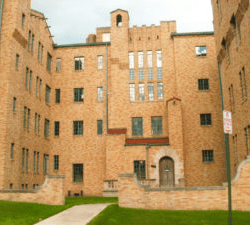
Credit: Preservation Resource Center of New Orleans
Homeowner and Property Owner Loans
Access to capital for stabilization, repairs, rehabilitation, or to correct code violations is a powerful tool to ensure a property’s survival and continued or new use. The burden on low-income homeowners to fulfill historic district requirements can mean the difference between neglect and historically appropriate upkeep. Preservation organizations around the country provide low or even no-interest loans to property owners to repair their homes or businesses and to buy time for a new use. Below are a sampling of programs. Do you have an innovative program to share? If so, email us here.

The Heritage Home Program Loan offered by the Cleveland Restoration Society provides fixed low-interest loans (as low as 1.4%) for homeowners to assist with rehabilitation projects for older homes. Clients also have access to technical assistance. To learn more, visit the program website.
Photo: “After” photo of a home in Cleveland that utilized the Heritage Home Program. Courtesy of Cleveland Restoration Society.

Historic Charleston Foundation
The Common Cause Loan Fund was established by the Historic Charleston Foundation and the Charleston Redevelopment Corporation to keep long-term homeowners in their homes. The loan program provides resources and technical assistance to qualifying homeowners for exterior repairs. This decreases the likelihood of low-income residents being forced out by displacement pressures or the threat of deteriorating living conditions.
Learn More:
- Common Cause Loan Fund
- Common Cause Loan Fund video
An example of one of the homes undergoing exterior repairs and maintenance through Historic Charleston Foundation’s Common Cause Loan Fund. Photo credit: Historic Charleston Foundation.

Historic Wilmington Foundation
The Historic Wilmington Foundation (HWF) partners with the City to save houses on the Demolition by Neglect list through its Preservation Equity Fund. When the City identifies an endangered property, it alerts HWF, whose staff works with homeowners. Technical assistance and grants are offered for needed repairs. This program directly addresses both affordable housing and climate change. The financial assistance to low-income families is one way to maintain affordable housing, reduces displacement, and keep material out of the landfill. More importantly, it keeps family in their homes and neighborhoods.
Learn More:
The owners of this house at South 7th Street were able to make much-needed repairs through Historic Wilmington Foundation’s Preservation Equity Fund. The program saved the house from demolition and kept the family in their home. Photo credit: Historic Wilmington Foundation.

Michigan Historic Preservation Network
MHPN has two loan programs: Predevelopment Loans and Intervention Loans. The first provides up to $50,000 for “reasonable third-party costs that occur in the early stages and are necessary in making the project happen.” Intervention loans are low-interest loans of up to $15,00 for emergency repairs or stabilization.
Photo: Casa Del Rey Apartments, Pontiac, MI, recipient of a Predevelopment Loan. Courtesy MHPN.

Preservation Buffalo Niagara offers two loan programs: the East Side Commercial Building Stabilization Fund and the Historic Home Loan Fund. The first fund is intended to protect the fabric, density, character, and community of the city’s East Side. The funds support stabilization of at-risk historic buildings to facilitate active use and business activity and can be used to rectify code violations. The latter provides financing for projects of locally designated homes for low income homeowners. This program also incorporates technical assistance.
Photo: Commercial building in Buffalo. Credit: Jeremy Ebersole.
